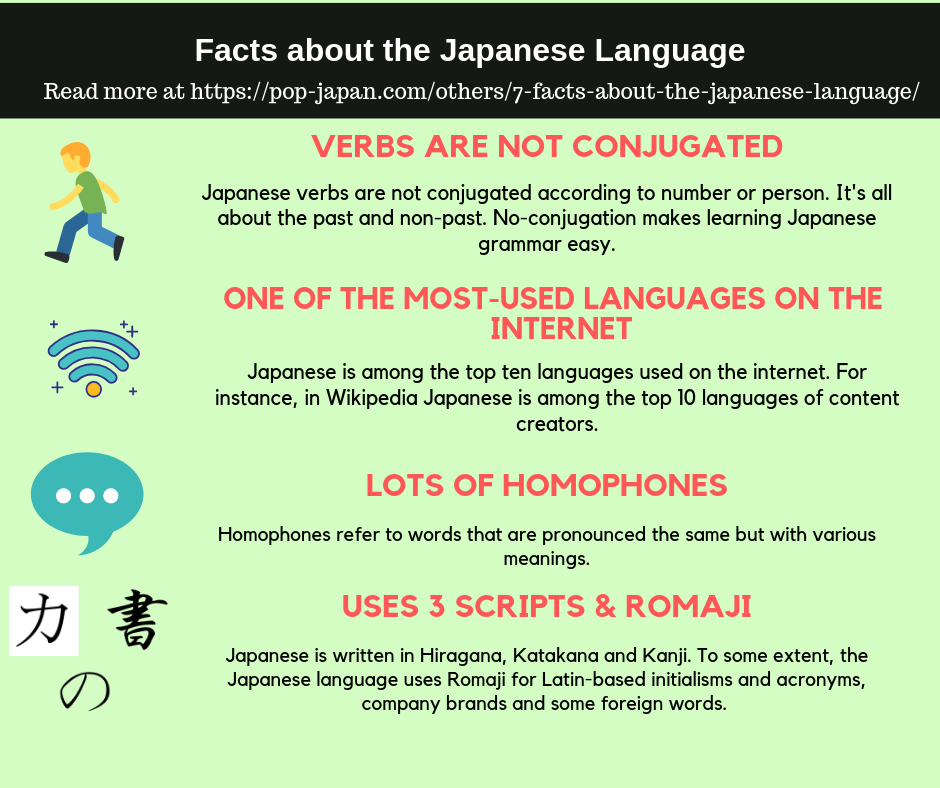7 Facts about the Japanese Language

Here are some of the Japanese facts that can help you decide and start learning the Japanese Language
1. Japanese grammar is easy to learn
Unlike some indo-European languages (English, German, Hindi), Japanese constitutes a straightforward
grammar. The verbs are not conjugated and they only have tenses past and non-past. That means no
confusing progressive, past-perfect tenses. You don't have to worry about gender and number (male/female and singular/plural). There is also no articles (The, A, An in English) and numbers (plural/singular) to differentiate the number of things. So you don't have to worry about the irregular spellings found in
English grammar.
2. Japanese is unrelated to any other language
It's not related to Chinese, English, Hindi, Spanish. Linguists call Japanese a language isolate - meaning it's unique.
3. It's among the most-used language on the internet.
For instance, in Wikipedia, It's among the top 10 languages that have the most number of contributed articles. There are also numerous Japanese blogs and websites encompassing blogs, articles, home pages, and company sites.
4. Japanese uses 4 scripts
The language uses 4 scripts such as Hiragana (for native Japanese words), katakana (for foreign words), and Kanji is used to make sentences readable and to give meaning to words as there is no space in Japanese sentences. In some situations, Romaji (latin alphabet) is used to represent corporate names,
Latin-based acronyms such as UN and ILO and some foreign words except for writing complex pronunciations, homonyms and homophones.
5. There are lots of homophones
Japanese homophones are words that sound the same but with different meanings. You will come across many homophones while you advance your Japanese language learning.
hashi (rising intonation) means bridge
hashi (falling intonation) means chopsticks
Note: in Kansai dialcet in Osaka and western Japan, the above homophones is reversed.
Kikai 奇怪 Strange
Kikai 機械 Machine
Kikai 毀壊 destruction
Kikai 機会 opportunity
In Romaji
Haku - throw up
Haku - to put on
iru - at, exist
iru - need, want
Kaburu - to get a rash
Kaburu - to wear
kaki - mussel
kaki - persimmon
Kiku - to write
Kiku - chrysanthemum
Haku - throw up
Haku - to put on
Kaku - to write
Kaku - to itch
Kumo - cloud
Kumo - Spider
sake - rice wine
sake - salmon fish
Umi - sea, ocean
Umi - Oozing puss
6. The Japanese language is called "Nihongo" in the native tongue.
The term "Japanese" is derived from the word "Jipangu" which was first recorded by the Portuguese when they heard "cipan" from the Chinese Mandarin pronunciation.
7. The Japanese language is unrelated to Chinese although the Japanese people use the Kanji script that is from Chinese.
In the 5th century, Japanese scholars borrowed Kanji and incorporated them into the Japanese writing system. After borrowing the script, they devised a script that we know as Hiragana.
Tags: Language, Japanese language, scripts, Languages, Japan, Hiragana, katakana, Kanji, Nihongo, Homophones
July 07, 2022
June 09, 2022
March 31, 2022
February 02, 2022
December 09, 2021
November 17, 2021
November 12, 2021
September 28, 2021
September 27, 2021
Signup
- Sign Up
- Already a member? Login Now!
